Baby Spinach vs Spinach: Which is Better? A Comparison
As a Certified Health Coach, I spend much time educating people about healthy foods including spinach. Baby spinach and spinach are both popular but is there a difference?
Baby spinach and spinach are the same plant harvested at different times. Baby spinach is younger and has only grown for two to four weeks while regular, mature spinach grows for almost two months before harvesting. Baby spinach has smaller leaves and tastes sweeter than the more bitter mature spinach.
This article will examine their tastes, textures, prices and if one can substitute for the other. In addition, I’ll include which dishes are better for each one and examine the differences in their nutrients.
In addition to coaching clients about spinach, I’ve purchased, researched and consumed both prior to, during and after writing this article. I include both leaf spinach as part of my nutrition plan.
Baby Spinach vs Spinach: Differences
The following are differences between the two types:
- Baby spinach is harvested after 2 to 4 weeks while mature is harvested approximately 1 1/2 to 2 months.
- Baby spinach leaves are small, growing up to two inches. Mature leaves are larger, but some may be small.
- Mature leaves are a darker green and thicker.
- Baby tastes sweeter and juicier than regular which is more bitter and earthy.
- Baby spinach costs more.
- Baby spinach is better consumed raw and spinach cooked.
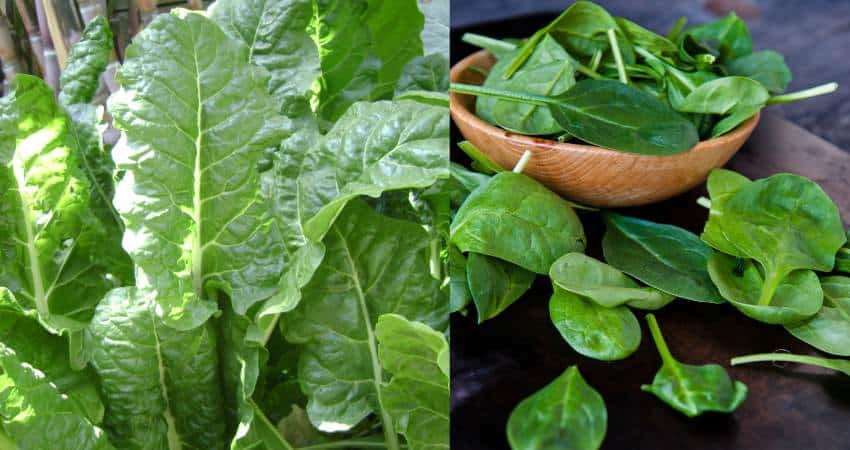
Baby Spinach vs Mature Spinach: Taste and Texture
Besides the size of the leaves, the taste and texture is the biggest difference between the two. Therefore, let’s examine the difference in taste between the two.
Spinach has a bitter and earthy taste. Baby spinach has a hint of bitterness and earthiness but is sweeter and more mild than spinach. Baby spinach is juicier and more tender. The bitterness of mature lessens when cooked.
I wanted to conduct original research and find out what real people like you thought about the taste of each one. Therefore, I polled my clients, readers and people belonging to food groups and asked, what tastes better?
- 41% said they preferred the taste of spinach.
- 44% said they preferred the taste of baby spinach.
- 15% said they had no preference.
To conduct more research, I setup and participated in a taste home at home. After eating spinach, the mature and baby type, three out of four people chose the baby due to its less bitterness.
Most people polled said baby spinach has more of a sweeter flavor than its mature variety.
Your personal preference is the deciding factor between which type you purchase. Both are delicious and can aid different culinary creations.
Some of the flavor qualities you may find in baby are:
- It can be creamy and works great with dishes delivering that flavor.
- It has a soft consistency. The texture may be important if you are eating it raw.
- It has earth tones, but it has a vibrant flavor.
On the other hand, mature spinach has specific taste qualities as well:
- The leaves are crispy and thick, making them crunchy when you eat.
- The flavor of mature is earth-like and not as tasty as baby spinach.
- Mature is excellent for salads, sandwiches and earthy recipes.
Give both types a try for yourself, and see which one you prefer. Next, let’s examine which one is better for different cooking methods.
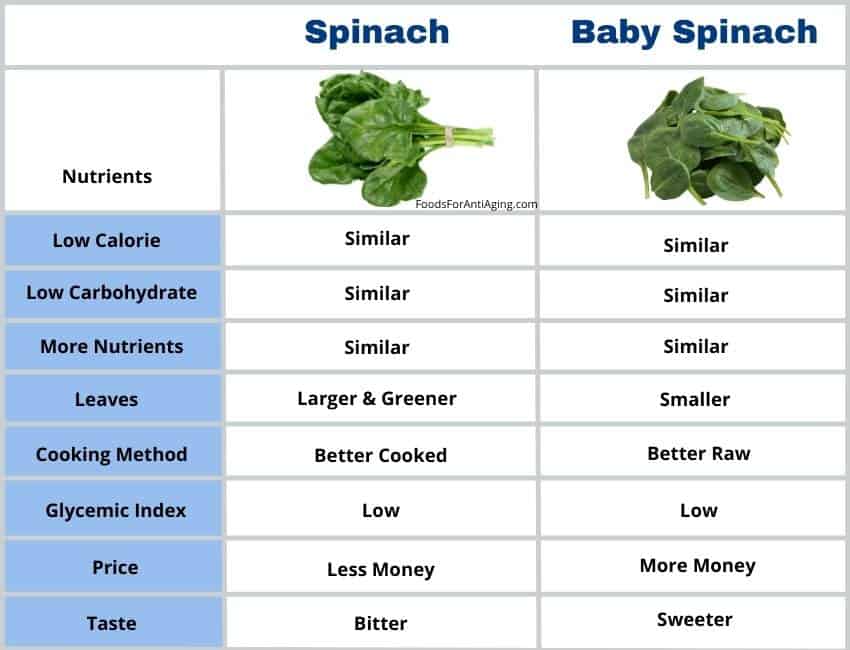
Cook Baby Spinach?
Besides the taste, choosing a particular one for the dish you’re planning is important. Both are known to work well with specific culinary dishes.
Mature spinach is better for cooking while baby spinach is more suitable for raw consumption and salad. Baby spinach turns slimier and mushier when cooked compared to spinach. The less bitter baby spinach is better for salads, wraps, smoothies and sandwiches.
Therefore, it’s not the best to cook baby, it is better for the following:
- Salad
- Smoothies
- Wraps
- Sandwiches
Spinach is better for the following:
- Sauteing
- Steaming
- Roasting
- Pizza topping
- Any type of cooking.
Either one can be used raw or for cooking but for the best results most people follow the suggestions above.
I tend to use baby more often and add it to my smoothies or salads. As a cooked side dish I use the mature leafs.
The following video explains the benefits of spinach and some cautions.
Cooking and Eating Spinach for Best Taste
When cooking, add a more significant amount than may be necessary. The spinach will shrink in size, and your portion may appear to be much smaller. Baby spinach tends to be tasteless and has a mushy texture to it when it is heated.
The mature variety is earthy in flavor and a bit bitter. However, the flavors increase when heated. It’s texture also changes when heated because it is a hydrating vegetable.
Before cooking it, it’s best to prepare. Follow these three steps before cooking:
- Wash the spinach with cold water.
- Prepare it by trimming, if needed, to curate nice and tender leaves.
- You can wash it a second time and dry the leaves if desired.
Starting with the best leaves from the start is important for freshness and storage. Therefore, when shopping follow these tips:
- Choose ones with the darkest green leaves.
- Avoid leaves which are yellowing.
- Avoid wilted leaves and choose crispy ones.
Have you heard of savoy spinach? Savoy spinach has curly, crinkly leaves which are darker than most of spinach types. Most people find them better for a cooking recipe than eating raw.
If cost is a factor, let’s examine which one costs less.
The video below explains a great way for you to cook spinach in only two minutes.
Prices
Prices seem to go up every time I visit the supermarket. Since the cost of food matters to most people let’s take a look at the prices for both foods and determine which cost more.
Baby spinach cost more money per ounce than spinach. The cost for baby spinach averages $0.33 per ounce and spinach averages $0.16 per ounce.
To conduct some original research, I visited local supermarkets and checked the prices of both. Here are my findings.
First I visited a Walmart Supercenter:
- Marketside bagged fresh spinach
- 10 ounce bag for $1.98. Equals $0.20 per ounce
- Marketside fresh baby spinach
- 11 ounce container for $3.98. Equals $0.36 per ounce
I then checked my local Shoprite supermarket:
- Bowl and basket chopped spinach
- 10 ounce bag for $1.29. Equals $0.13 per ounce
- Bowl and basket baby spinach
- 16 ounce container for $4.99. Equals $0.31 per ounce
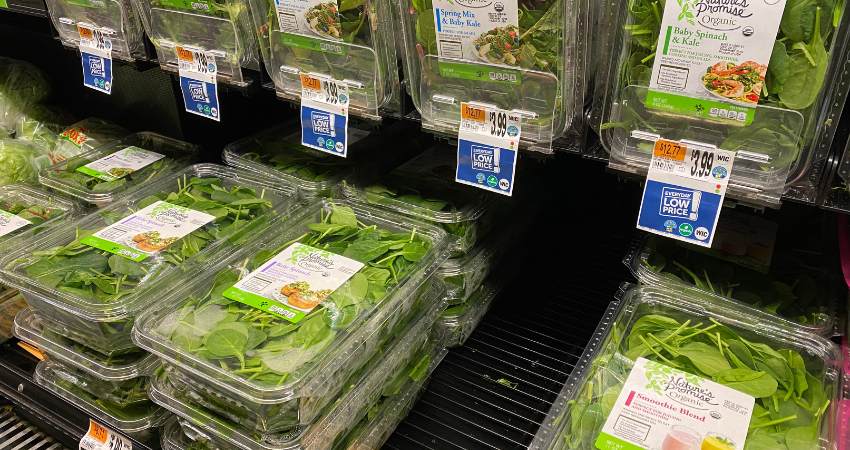
Nutrition Comparison
The following table compares the nutrients contained in both per 100 grams.
| Spinach (100 g) | Baby Spinach (100 g) | |
| Calories | 22 | 21 |
| Protein | 2.91 g | 2.85 g |
| Carbohydrates | 2.64 g | 2.41 g |
| Fiber | 1.6 g | 1.6 g |
| Fat | 0.60 g | 0.62 g |
| Beta-carotene | 3,670 mcg | 3,400 mcg |
| Vitamin C | 30.3 mg | 26.5 mg |
| Vitamin D | 0 IU | 0 IU |
| Vitamin B6 | 0.21 mg | 0.20 mg |
| Vitamin B9 (Folate) | 113 mcg | 116 mcg |
| Vitamin B1 (Thiamin) | 0.07 mg | 0.07 mg |
| Vitamin B2 (Riboflavin) | 0.19 mg | 0.19 mg |
| Vitamin B3 (Niacin) | 0.51 mg | 0.55 mg |
| Magnesium | 93 mg | 93 mg |
| Phosphorous | 41 mg | 39 mg |
| Potassium | 460 mg | 582 mg |
| Iron | 1.05 mg | 1.26 mg |
| Copper | 0.08 mg | 0.08 mg |
| Calcium | 67 mg | 68 mg |
| Zinc | 0.42 mg | 0.45 mg |
Both varieties have a similar number and percentage of nutrients. Baby spinach provides a little more potassium and iron while spinach provides a little more protein, vitamin C and beta-carotene.
The small differences in nutrients between the two don’t make either one healthier than the other.
Both have a similar number of calories, carbohydrates, fiber, B vitamins, magnesium, phosphorus, copper, calcium and zinc.
Therefore, both are good options for the following:
- Losing weight
- Bodybuilding
- Low-carb or Keto diets
- Gluten free diets
Find out if kale had more nutrients in my article and who won the superfood showdown.
Health Benefits of Baby Spinach and Spinach
Since the nutrients provided are similar, the health benefits offered from eating either food is also similar. Let’s examine how the nutrients provided benefit health.
Vitamin C
- Spinach contains more vitamin C per 100 grams.
Vitamin C acts as an antioxidant and helps with the following:
- Prevent cell damage.
- Help heal wounds.
- May help boost the immune system.
- Collagen production.
- Increases iron absorption.
- Help maintain health gums.
In the following video an accredited hospital and doctor explain the health benefits of spinach.
B Vitamins
- Spinach provides a higher percentage of B6.
- Baby spinach provides a higher percentage of folate and niacin.
The B vitamins provided by both include the following:
- B1 (thiamin)
- B2 (riboflavin)
- B3 (niacin)
- B5
- B6
- B9 (folate)
B vitamins help support the following:
- Digestion.
- Brain function.
- Nerve function.
- Energy levels.
- Red blood cells.
- Cardiovascular disease.
Vitamin A & Beta Carotene
- Mature spinach contains more beta carotene per 100 grams.
Beta-carotene is a compound present in both. The body converts beta-carotene into vitamin A.
According to scientific studies, vitamin A helps the eyes when it comes to dim light vision and dry eyes ((National Center for Biotechnology Information: Nutrients for the aging eye)).
Besides eye health, an increased number of vitamin A has been shown to fight and prevent cardiovascular disease, which is the leading cause of death in the United States3.
Vitamin A is a powerful antioxidant that can help reduce cellular damage by controlling the negative effects of free radicals4.

Phosphorus
- Mature spinach contains a little more phosphorus per 100 grams.
Phosphorus has been shown in scientific studies to help with the following:
- Promote teeth and bone health.
- Help the kidneys remove waste.
- Promote healthy nerve conduction.
- Help the body manage and store energy.
- Muscle contraction and recovery.
Find out if collard greens are better in my article. Did they have more nutrients?
Magnesium
- Both contains the same amount of magnesium per 100 grams.
Magnesium helps the body control the following:
- Muscle function
- Nerve function
- Blood sugar
- Insomnia
- Systolic and diastolic blood pressure
In the heart and muscles, magnesium competes with calcium to help the muscles relax after contracting. When the body is low in magnesium, calcium can over stimulate the heart muscle’s cells causing a rapid or irregular heartbeat5.
One reason many people supplement with magnesium in the evening is because it helps calm the whole body including blood vessels.
Magnesium helps keep blood pressure levels stable and balanced. Recent scientific research examined previous studies and concluded magnesium supplementation decreased systolic and diastolic blood pressure6.

Potassium
- Baby spinach contains more potassium per 100 grams.
Potassium helps the body reduce excess fluid therefore reducing systolic and diastolic blood pressure7.
According to Harvard Health, a number of studies have shown a connection between low potassium levels and high blood pressure8. The more potassium, the more sodium your body will lose.
Some medical experts recommend the potassium to sodium ratio of 4:1. Consuming not enough potassium or too much sodium throws off the delicate balance the kidneys need to remove the excess water9.
Calcium
- Both contains approximately 68 mg of calcium per 100 grams.
Calcium helps the following:
- Help the muscles to function properly.
- Helps nerve function.
- Build and maintain strong bones.
In addition, calcium is important for the heart and blood pressure. Harvard Health reports calcium helps maintain blood pressure by helping in the controlling of the relaxing and tightening of blood vessels10.
Iron
- Baby spinach contains 1.26 mg of iron per 100 grams.
Iron is a necessary part of any healthy diet11 and may help with the following:
- Vital for development and growth.
- Is essential the creation of red blood cells.
- Help some hormones remain balanced.
- Help the immune system.
Find out which spinach type has more nutrients in my comparison article.
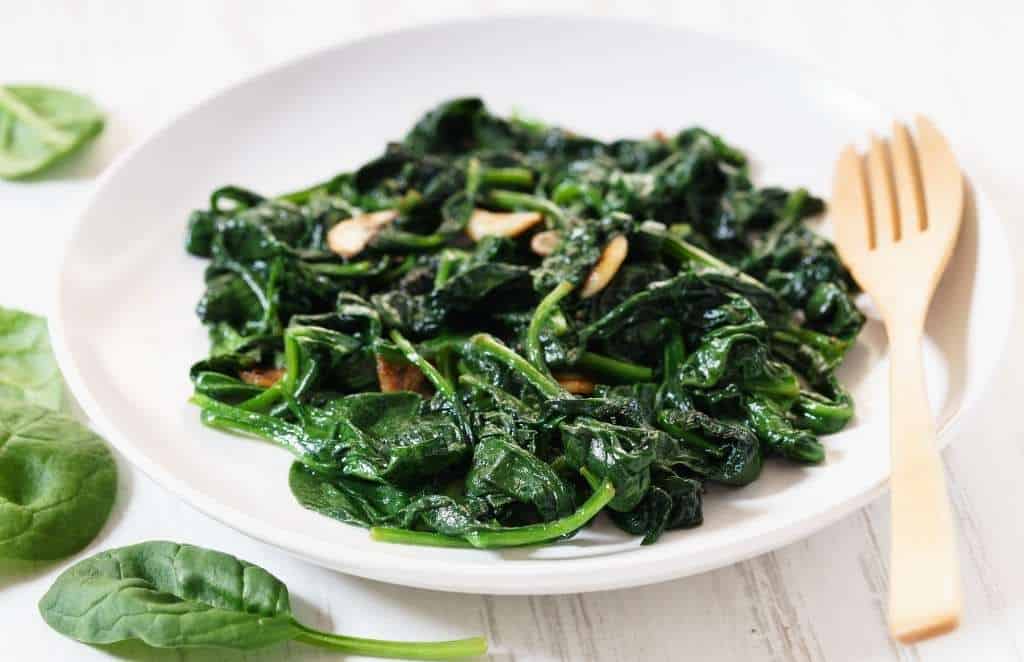
Glycemic Index
The Glycemic Index (GI) is a scale measuring how fast a particular food raises the blood sugar in the blood12. Blood sugar spikes can lead to health complications with the heart, nerves, kidneys and eyes13.
Foods on the GI scale are categorized as:
- Low-GI foods: 55 or under
- Medium-GI foods: 56-69
- High-GI foods: 70 or over
Since avoiding high levels of blood sugar is an important part of consuming healthy food, many people wonder about the glycemic index of each food.
Baby spinach and spinach are both low glycemic foods and shouldn’t cause any spikes in blood sugar.
Besides the two, all leafy greens have a low glycemic index.
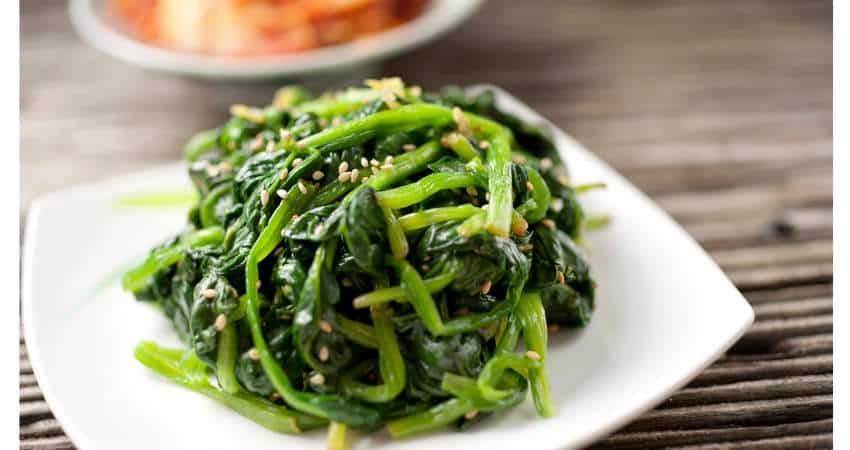
If you have any questions about this article don’t hesitate to email us. You can find an email on our contact page.
Read More Spinach Food vs Food Articles
Spinach vs Broccoli: Which is Better? A Complete Comparison
Frozen Spinach vs Fresh: Which is Better? A Comparison
Arugula vs Spinach: Which is Better? A Complete Comparison
Organic Spinach vs. Regular Spinach: What’s The Difference?
Spinach vs Lettuce: Which is Better? A Complete Comparison
- USDA: Spinach, baby [↩]
- USDA: Spinach, mature [↩]
- National Center for Biotechnology Information: Antioxidant potentials of vitamin A and carotenoids and their relevance to heart disease [↩]
- National Center for Biotechnology Information: Free radicals, antioxidants and functional foods: Impact on human health [↩]
- National Institutes of Health: Magnesium [↩]
- National Center for Biotechnology Information: Effect of magnesium supplementation on blood pressure: a meta-analysis [↩]
- American Heart Association: How Potassium Can Help Control High Blood Pressure [↩]
- Harvard Health: Potassium lowers blood pressure [↩]
- National Center for Biotechnology Information: The Effect of the Sodium to Potassium Ratio on Hypertension Prevalence: A Propensity Score Matching Approach [↩]
- Harvard Health: Key minerals to help control blood pressure [↩]
- National Institutes of Health: Iron [↩]
- Harvard Health Publishing: Glycemic index for 60+ foods [↩]
- National Institute of Diabetes and Digestive and Kidney Diseases: Know Your Blood Sugar Numbers: Use Them to Manage Your Diabetes [↩]
